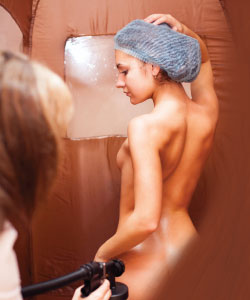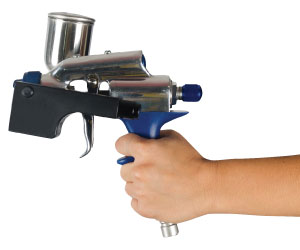Summer is a fantastic time for skin care professionals to flex their ingredient knowledge and business know-how when it comes to sun protection and airbrush tanning. Clients crave exceptional consumer education and need expert knowledge to propel forward in their daily and weekly skin care routines. With bikini season in bloom and the sun rays hitting the sand, professionals are in an excellent position to educate clients and assist them in protecting one of their most-valuable assets: their skin.
Professionals should fully understand ingredient definitions and additives in order to extend their life as a true industry professional.
SUNSCREEN
Consumer education on the difference between over-the-counter sunscreens and professional-level sunscreens is greatly lacking. As a result, skin care professionals should be able to discuss the difference between the two types of products in great detail. The true distinction between the two types of sunscreens, relative to skin allergies and irritations, include understanding the difference between a physical and chemical sunscreen.
Professional-Level Sunscreen Additives
- The following ingredients are different examples of professional-level sunscreen additives that provide a better glide on the skin and produce happier clients when it comes to purchases and the potential for skin irritation.
- Dimethicone: A silicon-based polymer that conditions and protects the skin, assists in the spreadability of the product, and acts as a fantastic makeup primer.
- Iron Oxide: A safe, natural colorant that is used to add a flesh-toned tint to the skin.
- Panthenol: A form of vitamin B5 that helps increase the skin's hyaluronic acid content and helps stabilize the moisture content of the skin, which increases the resistance to irritation and improves the skin's ability to take in oxygen.
- Hyaluronic Acid: Attracts and maintains hydration to hold 1,000 times its weight in water. It also prevents transepidermal water loss and protects against free-radical damage.
- Palmitoyl Pentapeptide-3: A lipopeptide that consists of a fatty acid mixed with amino acids and has been shown to increase collagen and hyaluronic acid synthesis to improve the appearance of wrinkles.
- Tocopherol (Vitamin E): An antioxidant that has anti-inflammatory properties and stimulates the immune system, protecting the skin from the adverse effects of oxidative stress, including photoaging.
Common Sunscreen Ingredients
- Octisalate: A safe, UVB-absorbing sunscreen that is generally used in combination with other ultraviolet filters.

- Octinoxate: A widely used sunscreen that absorbs UVB rays and protects against ultraviolet light-induced DNA damage.
- Avobenzone: A sunscreen agent that is often used in skin care because of its capability of absorbing the full range of UVA rays, helping to reduce the risk of premature aging and
- skin cancer.
- Oxybenzone: A sunscreen ingredient that absorbs UVB and shortwave UVA rays.
- Zinc Oxide: This ingredient is a safe and non-irritating physical sun protectant. It is a broad spectrum UVB and UVA sunscreen that is also used for its soothing properties.
- Titanium Dioxide: This ingredient provides physical protection from ultraviolet radiation and prevents sun damage and excessive melanin synthesis.
Physical Sunscreen – These products contain natural minerals that physically sit on top of the skin in order to block damaging ultraviolet rays. A few examples of ingredients in physical sunscreens include titanium dioxide and zinc oxide. In over-the-counter physical sunscreens, the solution can be thick and messy, producing a white sheen and leaving behind residue.
Chemical Sunscreen – This type of sunscreen is completely absorbed by the skin in order to provide an underlying protection through ingredients, such as oxybenzone and octinoxate. Certain chemical sunscreen ingredients can cause potential skin irritations and allergic responses if they are formulated improperly.
AIRBRUSH TANNING
The faux summer glow is a fantastic avenue to tap into during the summer months and beyond. When performed properly, and through amazing consumer education, professionals can be on top of the airbrush tanning market in their area. The business of airbrush tanning consists of strong ingredient and formulation education, along with the correct understanding of what business model the professional prefers to perform in – either a studio setting or on-location. Through amazing client education, skin care professionals can propel their profit margins exponentially through sun protection and airbrush tanning and become true experts in the niche market of healthy tanning.
The business of airbrush tanning is fast-paced, with after-hours appointments being a must. Make sure to be available after 5 p.m. and on the weekends and deliver an outstanding home-delivery service, if possible. Having an online booking and payment option is crucial on the administrative end, as well as a lightweight airbrushing machine, roller cart, and airbrushing tent that can easily be disinfected and washed between clients. Clients want less talk and more action, so be prepared to get in and out quickly and efficiently. Call, e-mail, or even text the client the next day to make sure their airbrush tan turned out as expected and provide them with an e-mail of pre- and post-care tips for optimum results.
Airbrush tanning professionals must understand the perfect techniques for tanning, as the hand-spraying method is more popular for its customized applications. A true flick-of-the-wrist application is crucial, in addition to feathering off on areas such as elbows, hands, knees, and feet. Providing clients with the proper tools during their session, such as blending cream for those areas, disposable tanning caps, and disposable underwear, are inherently ideal. Feeling comfortable and knowledgeable about the airbrush tanning solution being used is also key, as there are many different formulations. Some solutions will contain added vitamins and minerals, while others will contain more cosmetic bronzers for instant color and rapid tanning.
Do not forget to include a gradual tanner and/or topical moisturizer with the client's tanning package, as the dihydroxyacetone (DHA) will cause a drying effect on the skin. Gradual tanners used over the life of an airbrush tan will prolong the tan and assist in a beautiful fade-off effect as the tan wears away.
THE BUSINESS OF AIRBRUSH TANNING
The business of airbrush tanning begins with a complete understanding and respect for sanitation practices. Safe practices when dealing with the skin and body is as important in tanning as it is in the skin care treatment room. Utilizing Standard Precautions, as outlined by OSHA, is crucial in maintaining an excellent reputation and building personal professionalism in the industry. Taking sanitation into consideration when using disposable items, differentiating the room's closed containers for both clean and soiled linens, and using an Environmental Protection Agency-registered, hospital-grade disinfectant to clean the tanning tent or booth and the surrounding areas between clients is exceptionally important.
The proper tool kit for any airbrush tanning professional is an integral part of creating a seamless experience for the client. Utilizing a lightweight, industrial-strength airbrush tanning compressor and a bottom-feeding airbrush gun is not only easy to tote around for on-location clients, but also easy to break down and clean, when needed. A foldable airbrush tanning tent that is easy to wipe down and clean is another necessary tool for professionals as it can be utilized both indoors and outdoors for a private tanning experience in any environment. The proper airbrush tanning solution is one that is individually chosen through specific needs and desires. Look for airbrush tanning solutions that have gentle ingredients for all skin types and a purple undertone in its coloring in order to provide the client with a brown finish instead of the dreaded orange tanning color that clients despise. Doing some research with sample colors until a solution that stands out is found is an important decision. There are many brands that offer not only different finishing options, but also color depth options, add-in options, and different ingredients per skin type and desire.
Airbrush Tanning Ingredients
- DHA: Dihydroxyacetone is the ingredient that creates the tanning effect. When placed on the skin, DHA reacts with amino acids and proteins on the skin's surface layer and causes the skin to oxidize, creating a tan. The tan presents within two or three hours, with peak color reached in 24 hours. DHA is derived from the sugar cane and has a long history of safe use.
- Aloe: Aloe vera can be found in many spray tanning solutions. According to the National Center for Complementary and Alternative Medicine, it has traditionally been used as a skin-healing aid and can be found in hundreds of cosmetic products.
- Stabilizer: Disodium EDTA, or ethylenediaminetetraacetic acid, is used as a stabilizer. It prevents ingredients from binding with trace elements in water and with other ingredients. Such binding can cause undesired changes to the odor, texture, or consistency of a product.
- Other Ingredients: Citric acid is used in some spray tanners to adjust the pH. This organic acid occurs naturally in citrus fruits. Ethoxydiglycol may be used as a solvent to dissolve or break down some of the other ingredients in the formula. Propylene glycol is a synthetic product that can aid in skin penetration of the spray tan.

PRE- AND POST-CARE PRACTICES FOR AIRBRUSH TANNING
The best time for a client to receive an airbrush tan is before going home at night or when they are going to go straight home and lounge for four to six hours. Clients risk streaking the tan by doing too much moving around in tight-fitting clothes or through the rubbing of the tan on the clothes they are wearing. They also risk sweating when they run in and out of different temperatures throughout the day while the tan is still processing. 
The best pre-care tanning protocols include exfoliating through an at-home scrub or receiving a professional, enzyme-based body exfoliation with a skin care professional; wearing loose-fitting clothing and sandals to the appointment; using a blending cream on the hands, elbows, knees, and feet; utilizing the correct towels or foot protection when turning the client, to prevent staining on the soles of the feet; and providing the client with proper disposables, such as hair caps and string bikinis, if needed.
Allow the client to air dry in a private, air-filtered space for as long as they feel they need to before putting on clothes to conclude the appointment. Approximately five to 10 minutes is plenty of time to expect the client to dry before assisting them with post-care education.
The best post-care tanning education includes the understanding that the tan requires daily maintenance in the form of a gradual tanner and/or bronzers added into their daily body moisturizers, both morning and night, to prolong the tan and also to assist in the tan fading off as evenly as possible and the comprehension that the continued use of sunscreen is still required daily, as an airbrush tan does not replace the use of sun protection on the skin.
Facial tanning can be an optional item, as clients should continue exfoliating and maintaining their normal skin routine. If facial tanning is requested, the client must understand that the tan will fade faster on the face due to constant exfoliation. Proper makeup education is another service for the client altogether and helps to showcase contouring and highlighting techniques.
Airbrush tanning is one of the most sought-after services due to its instant gratification for the client. Clients flock to salons and spas, and even call their favorite on-location specialists, in order to achieve the best golden glow around. Maintaining proper protocol, sanitation practices, and modern techniques are some of the amazing tools a professional must possess in order to achieve aesthetics excellence in today's spa industry.
 Courtney Freeman is the owner and lead instructor at Southeastern Esthetics Institute in Columbia, S.C., the leading institute in the southeast for the advanced esthetics licensure course. Freeman is also the owner of Pura Medical Spa in downtown Columbia and has dedicated her life and career to exceptional aesthetic education through advanced skin science knowledge with a medical focus.
Courtney Freeman is the owner and lead instructor at Southeastern Esthetics Institute in Columbia, S.C., the leading institute in the southeast for the advanced esthetics licensure course. Freeman is also the owner of Pura Medical Spa in downtown Columbia and has dedicated her life and career to exceptional aesthetic education through advanced skin science knowledge with a medical focus.
Want to read more?
Subscribe to one of our monthly plans to continue reading this article.